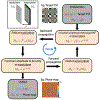PhlatCam: Designed Phase-Mask Based Thin Lensless Camera
- PMID: 32324539
- PMCID: PMC7439257
- DOI: 10.1109/TPAMI.2020.2987489
PhlatCam: Designed Phase-Mask Based Thin Lensless Camera
Abstract
We demonstrate a versatile thin lensless camera with a designed phase-mask placed at sub-2 mm from an imaging CMOS sensor. Using wave optics and phase retrieval methods, we present a general-purpose framework to create phase-masks that achieve desired sharp point-spread-functions (PSFs) for desired camera thicknesses. From a single 2D encoded measurement, we show the reconstruction of high-resolution 2D images, computational refocusing, and 3D imaging. This ability is made possible by our proposed high-performance contour-based PSF. The heuristic contour-based PSF is designed using concepts in signal processing to achieve maximal information transfer to a bit-depth limited sensor. Due to the efficient coding, we can use fast linear methods for high-quality image reconstructions and switch to iterative nonlinear methods for higher fidelity reconstructions and 3D imaging.
Figures

















References
-
- Geiger A, Lenz P, Stiller C, and Urtasun R, “Vision meets robotics: The kitti dataset,” The International Journal of Robotics Research, vol. 32, no. 11, pp. 1231–1237, 2013.
-
- Cornacchia M, Ozcan K, Zheng Y, and Velipasalar S, “A survey on activity detection and classification using wearable sensors,” IEEE Sensors Journal, vol. 17, no. 2, pp. 386–403, 2016.
-
- Eliakim R, Fireman Z, Gralnek I, Yassin K, Waterman M, Kopelman Y, Lachter J, Koslowsky B, and Adler S, “Evaluation of the pillcam colon capsule in the detection of colonic pathology: results of the first multicenter, prospective, comparative study,” Endoscopy, vol. 38, no. 10, pp. 963–970, 2006. - PubMed
-
- Wei S-E, Saragih J, Simon T, Harley AW, Lombardi S, Perdoch M, Hypes A, Wang D, Badino H, and Sheikh Y, “Vr facial animation via multiview image translation,” ACM Transactions on Graphics (TOG), vol. 38, no. 4, p. 67, 2019.
-
- Ren Z, Meng J, and Yuan J, “Depth camera based hand gesture recognition and its applications in human-computer-interaction,” in 2011 8th International Conference on Information, Communications & Signal Processing IEEE, 2011, pp. 1–5.
Grants and funding
LinkOut - more resources
Full Text Sources
Other Literature Sources

